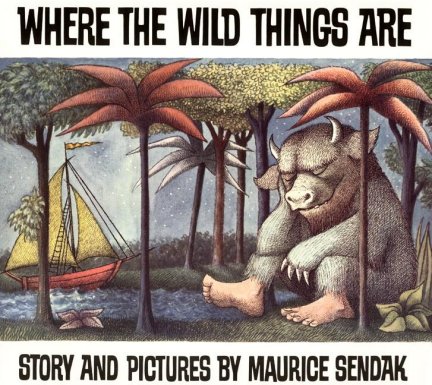With that line begins one of the most coveted picture books in contemporary children's literature.
Maurice Sendak won the Caldecott Medal in 1964 for Where the Wild Things Are, which he both
wrote and illustrated - and which, in turn, is intensely collected today. A jacketed first edition
of Where the Wild Things Are can go for as much as $12,000. Do be careful, however. A true first will in all likelihood not have a Caldecott Medal affixed to the dust jacket. There may be some firsts out there that do, but they would necessarily be rare. The Caldecott and Newbery Medals are presented at the American Library Association Midwinter meeting in January. Once the winner is announced, publisher representatives rush back to the exhibit area and slap stickers on remaining copies only - thus the scarcity of stickered firsts. [EDITOR'S NOTE: See "More Information on Illustrator Awards" at the end of this article.]

In addition to the sticker issue, it's important to note that later state dust jackets, which
mention the Caldecott Medal, cannot be plausibly married to jacketless first editions of
Where the Wild Things Are, which don't, whether a sticker is present or not.
After 42 years, the book is still in print, as are most Newbery and Caldecott winners. Also, over
the years, it has been picked up by numerous book clubs, so copies abound. BCE copies are easy
to spot: no dust jacket, a color pictorial cover and shoddy binding. Leave them behind. And don't
give up hope of finding a true first. 1964 is not at all ancient in book time. eBay searches often
reveal that true firsts of The Cat and the Hat, a cotemporary to Where the Wild Things Are, still surface in the oddest places. Book scouting is like gambling. You never know when you are going to hit the big one!
Wild Things was not Sendak's first foray into publishing. He debuted in 1948, illustrating a
school reader titled The Atomic Age (sometimes titled Atomics for the Millions). Always
check vintage readers to see who the illustrator is. An amazing number of well-known illustrators got
their start this way. I once found a reader with lovely color drawings by Elizabeth Enright, a niece
of Frank Lloyd Wright, who went on to become a Newbery winner in her own right for Thimble Summer.
Should you come across a book like this, make certain to include appropriate keywords in the auction title.
Maurice Sendak was born in 1928 in Brooklyn, New York to Jewish immigrant parents. His family was
originally from Poland, and many of them were killed during the Holocaust. He was a sickly child
who enjoyed listening to his father's stories and escaped into reading. At the age of 12,
Walt Disney's Fantasia inspired him to become an illustrator.
A fortuitous meeting with legendary children's book editor Ursula Nordstrom of Harper & Brothers
led to his first commission - illustrating The Wonderful Farm by Marcel Ayme in 1951. He has since illustrated over 90 other books, as well as his own works.
Other than the books he's authored, he's best known for illustrating Elsie Minarik's
Little Bear series. True firsts of any of the Little Bear books will sell in the high
three figures, but again, leave book club editions on the table. Also keep an eye out for
The Nutshell Library (Alligators All Around, Chicken Soup with Rice,
One Was Johnny, and Pierre). Boxed sets are most desirable.
Where the Wild Things Are was in fact the first part of a trilogy. In the Night Kitchen
appeared next, followed by Outside over There. In the Night Kitchen features a naked boy, and Sendak left nothing to the imagination. To say the least, the book produced a storm of controversy when it was released, and many librarians "dressed" the little boy in construction paper pants or drew a diaper on him with White-Out. This title still regularly appears on the ALA's list of 'frequently challenged and banned books.' If you find a copy, do make sure the little boy hasn't been dressed by some overly zealous censor!
Sendak was in some ways a pioneer in children's picture books. He was one of the first
illustrators/writers to portray a dark, nightmarish side of childhood, and there is no shortage of
academic articles that attempt to analyze his work. Where the Wild Things Are has often been criticized as being too violent and frightening. The traditional happy ending is honored, however, and Max returns to find that his supper is "... still hot."
A motif in much of his Sendak's work is the moon, said to represent his mother watching over him as he was growing up. Several other children's illustrators employ similar devices. For Tomi Di Paola, it's pink hearts; Chris Van Allsburg inserts a picture of a white dog into each of this books, and Marc Brown hides the names of his children in his illustrations.
Unlike most children's illustrators, Sendak has ventured far afield from his original medium.
He's worked in television and cartooning with Really Rosie, which, with music composed by
Carole King, originally aired in the 1970's. Rosie was an early feminist icon. In 1984, he worked
with the Pacific Ballet Company to create an entirely new version of The Nutcracker (also
available in book form). This is another first edition to watch for, by the way, one with multiple
flashpoints since it crosses over into ballet memorabilia. The 1980's also saw him branch out
into opera set design, which included sets for his own personal favorite, Mozart's The Magic Flute.
Sendak's diversity has created a market for non-book items also. In fact, the highest priced Sendak offering on Abebooks isn't a book at all; it's a scarf! An $85,000 scarf. There are also shirts, posters, videos, DVDs, puppets, nursery décor, and stuffed animals, not to mention programs, librettos, sketches, limited editions, and costume and set design drawings. A quick search on Amazon returns over 2,400 results for Sendak. Consider picking up anything Sendak and collecting it until you have enough to create a 'keyword catching' lot for eBay.
Sendak's first Pop-Up book, Mommy? debuts at the end of September. Written by Arthur Yorinks, it's sure to be a best seller. Given the fragile nature of pop-ups and the longstanding popularity of Sendak, I plan to buy this book and stash it away for future sale!
More Information on Illustrator Awards
Both the American Library Association Annual Conference, held in the summer, and ALA Midwinter are a bookseller's dream. Exhibit passes are inexpensive and many, many authors attend and do book signings. Publishers bring out their best and brightest and strut their stuff for the librarians of the nation. The meetings are held in various large cities, so, if you live in a metropolitan area, it is worth
checking to see if your city is hosting the convention anytime in the near future.
The Caldecott Medal is awarded to an American illustrator and the Newbery to an American author. Both recipients, as well as the runners up, are scheduled for book-signings during the summer convention. If you are the speculating type, this is a good time to buy books and collect autographs. A word to the wise: Lately, Caldecott Medal books have shown more quality and stronger sales than their Newbery counterparts, which, with the exceptions of Kate DiCamillo and Christopher Curtis, have been rather forgettable in recent years.
The summer convention also features the presentation of the Laura Ingalls Wilder Award, which recognizes the full body of an author's works - Beverly Cleary for example. The winner does not always attend because the award is often given late in the author's life, when traveling is no longer possible. Winners who do attend also sign books.



